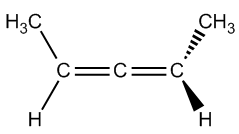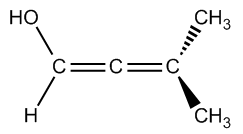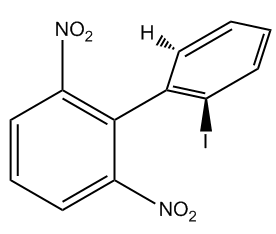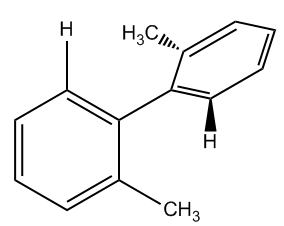Hey everyone. So now that I know in general terms how to predict what types of stereoisomers I'm going to get based on the number of chiral centers, I'm going to start teaching you some of those exceptions to the rules. And the first of those exceptions is a chiral compound that doesn't have any chiral centers at all, and these are called atropoisomers. Okay. So atropoisomers are these unusual compounds that contain no chiral centers, yet they actually are chiral due to their inability to freely rotate. Now it really depends, class by class, professor by professor, how much emphasis they put on these compounds because they are unusual and they're not ones that we deal with a whole lot in Orgo 1. But sometimes your professor might just throw these in as a trick so that you'll forget about these kinds of compounds that can't rotate. Okay? So here I have just a few. In fact, there's a few more, but these are the really common ones. So allenes. As you can see, allenes, they're two double bonds together. They can't rotate because double bonds can't rotate. Substituted biphenyls. I know you don't know what that is yet, but a biphenyl is just two phenyl groups that are attached in one spot and they're substituted, meaning that they can't really rotate because those substituents that you can see sticking out kind of act as teeth. They lock it together, so it can't fully rotate. Okay. Trans cyclooctene. This is actually a molecule that I was just recently talking about how it can form the cis version and the trans version. It turns out the trans version, because it can't rotate, it can actually form a right-handed version and a left-handed version of this twisted, messed-up thing, and is chiral because of the lack of rotation. Then finally, BINAP, which I don't even remember exactly what it stands for, but it's very similar to the substituted biphenyl where except in this case, one of an entire phenyl group or an entire benzene ring is acting as one of those teeth that are not going to let it rotate across that single bond. So, all of these are going to be chiral even though they lack chiral centers. These are, like I said, this is not the usual. This is not the norm. These are unusual molecules that happen to display chirality.
- 1. A Review of General Chemistry5h 5m
- Summary23m
- Intro to Organic Chemistry5m
- Atomic Structure16m
- Wave Function9m
- Molecular Orbitals17m
- Sigma and Pi Bonds9m
- Octet Rule12m
- Bonding Preferences12m
- Formal Charges6m
- Skeletal Structure14m
- Lewis Structure20m
- Condensed Structural Formula15m
- Degrees of Unsaturation15m
- Constitutional Isomers14m
- Resonance Structures46m
- Hybridization23m
- Molecular Geometry16m
- Electronegativity22m
- 2. Molecular Representations1h 14m
- 3. Acids and Bases2h 46m
- 4. Alkanes and Cycloalkanes4h 19m
- IUPAC Naming29m
- Alkyl Groups13m
- Naming Cycloalkanes10m
- Naming Bicyclic Compounds10m
- Naming Alkyl Halides7m
- Naming Alkenes3m
- Naming Alcohols8m
- Naming Amines15m
- Cis vs Trans21m
- Conformational Isomers13m
- Newman Projections14m
- Drawing Newman Projections16m
- Barrier To Rotation7m
- Ring Strain8m
- Axial vs Equatorial7m
- Cis vs Trans Conformations4m
- Equatorial Preference14m
- Chair Flip9m
- Calculating Energy Difference Between Chair Conformations17m
- A-Values17m
- Decalin7m
- 5. Chirality3h 39m
- Constitutional Isomers vs. Stereoisomers9m
- Chirality12m
- Test 1:Plane of Symmetry7m
- Test 2:Stereocenter Test17m
- R and S Configuration43m
- Enantiomers vs. Diastereomers13m
- Atropisomers9m
- Meso Compound12m
- Test 3:Disubstituted Cycloalkanes13m
- What is the Relationship Between Isomers?16m
- Fischer Projection10m
- R and S of Fischer Projections7m
- Optical Activity5m
- Enantiomeric Excess20m
- Calculations with Enantiomeric Percentages11m
- Non-Carbon Chiral Centers8m
- 6. Thermodynamics and Kinetics1h 22m
- 7. Substitution Reactions1h 48m
- 8. Elimination Reactions2h 30m
- 9. Alkenes and Alkynes2h 9m
- 10. Addition Reactions3h 18m
- Addition Reaction6m
- Markovnikov5m
- Hydrohalogenation6m
- Acid-Catalyzed Hydration17m
- Oxymercuration15m
- Hydroboration26m
- Hydrogenation6m
- Halogenation6m
- Halohydrin12m
- Carbene12m
- Epoxidation8m
- Epoxide Reactions9m
- Dihydroxylation8m
- Ozonolysis7m
- Ozonolysis Full Mechanism24m
- Oxidative Cleavage3m
- Alkyne Oxidative Cleavage6m
- Alkyne Hydrohalogenation3m
- Alkyne Halogenation2m
- Alkyne Hydration6m
- Alkyne Hydroboration2m
- 11. Radical Reactions1h 58m
- 12. Alcohols, Ethers, Epoxides and Thiols2h 42m
- Alcohol Nomenclature4m
- Naming Ethers6m
- Naming Epoxides18m
- Naming Thiols11m
- Alcohol Synthesis7m
- Leaving Group Conversions - Using HX11m
- Leaving Group Conversions - SOCl2 and PBr313m
- Leaving Group Conversions - Sulfonyl Chlorides7m
- Leaving Group Conversions Summary4m
- Williamson Ether Synthesis3m
- Making Ethers - Alkoxymercuration4m
- Making Ethers - Alcohol Condensation4m
- Making Ethers - Acid-Catalyzed Alkoxylation4m
- Making Ethers - Cumulative Practice10m
- Ether Cleavage8m
- Alcohol Protecting Groups3m
- t-Butyl Ether Protecting Groups5m
- Silyl Ether Protecting Groups10m
- Sharpless Epoxidation9m
- Thiol Reactions6m
- Sulfide Oxidation4m
- 13. Alcohols and Carbonyl Compounds2h 17m
- 14. Synthetic Techniques1h 26m
- 15. Analytical Techniques:IR, NMR, Mass Spect7h 3m
- Purpose of Analytical Techniques5m
- Infrared Spectroscopy16m
- Infrared Spectroscopy Table31m
- IR Spect:Drawing Spectra40m
- IR Spect:Extra Practice26m
- NMR Spectroscopy10m
- 1H NMR:Number of Signals26m
- 1H NMR:Q-Test26m
- 1H NMR:E/Z Diastereoisomerism8m
- H NMR Table24m
- 1H NMR:Spin-Splitting (N + 1) Rule22m
- 1H NMR:Spin-Splitting Simple Tree Diagrams11m
- 1H NMR:Spin-Splitting Complex Tree Diagrams12m
- 1H NMR:Spin-Splitting Patterns8m
- NMR Integration18m
- NMR Practice14m
- Carbon NMR4m
- Structure Determination without Mass Spect47m
- Mass Spectrometry12m
- Mass Spect:Fragmentation28m
- Mass Spect:Isotopes27m
- 16. Conjugated Systems6h 13m
- Conjugation Chemistry13m
- Stability of Conjugated Intermediates4m
- Allylic Halogenation12m
- Reactions at the Allylic Position39m
- Conjugated Hydrohalogenation (1,2 vs 1,4 addition)26m
- Diels-Alder Reaction9m
- Diels-Alder Forming Bridged Products11m
- Diels-Alder Retrosynthesis8m
- Molecular Orbital Theory9m
- Drawing Atomic Orbitals6m
- Drawing Molecular Orbitals17m
- HOMO LUMO4m
- Orbital Diagram:3-atoms- Allylic Ions13m
- Orbital Diagram:4-atoms- 1,3-butadiene11m
- Orbital Diagram:5-atoms- Allylic Ions10m
- Orbital Diagram:6-atoms- 1,3,5-hexatriene13m
- Orbital Diagram:Excited States4m
- Pericyclic Reaction10m
- Thermal Cycloaddition Reactions26m
- Photochemical Cycloaddition Reactions26m
- Thermal Electrocyclic Reactions14m
- Photochemical Electrocyclic Reactions10m
- Cumulative Electrocyclic Problems25m
- Sigmatropic Rearrangement17m
- Cope Rearrangement9m
- Claisen Rearrangement15m
- 17. Ultraviolet Spectroscopy51m
- 18. Aromaticity2h 34m
- 19. Reactions of Aromatics: EAS and Beyond5h 1m
- Electrophilic Aromatic Substitution9m
- Benzene Reactions11m
- EAS:Halogenation Mechanism6m
- EAS:Nitration Mechanism9m
- EAS:Friedel-Crafts Alkylation Mechanism6m
- EAS:Friedel-Crafts Acylation Mechanism5m
- EAS:Any Carbocation Mechanism7m
- Electron Withdrawing Groups22m
- EAS:Ortho vs. Para Positions4m
- Acylation of Aniline9m
- Limitations of Friedel-Crafts Alkyation19m
- Advantages of Friedel-Crafts Acylation6m
- Blocking Groups - Sulfonic Acid12m
- EAS:Synergistic and Competitive Groups13m
- Side-Chain Halogenation6m
- Side-Chain Oxidation4m
- Reactions at Benzylic Positions31m
- Birch Reduction10m
- EAS:Sequence Groups4m
- EAS:Retrosynthesis29m
- Diazo Replacement Reactions6m
- Diazo Sequence Groups5m
- Diazo Retrosynthesis13m
- Nucleophilic Aromatic Substitution28m
- Benzyne16m
- 20. Phenols55m
- 21. Aldehydes and Ketones: Nucleophilic Addition4h 56m
- Naming Aldehydes8m
- Naming Ketones7m
- Oxidizing and Reducing Agents9m
- Oxidation of Alcohols28m
- Ozonolysis7m
- DIBAL5m
- Alkyne Hydration9m
- Nucleophilic Addition8m
- Cyanohydrin11m
- Organometallics on Ketones19m
- Overview of Nucleophilic Addition of Solvents13m
- Hydrates6m
- Hemiacetal9m
- Acetal12m
- Acetal Protecting Group16m
- Thioacetal6m
- Imine vs Enamine15m
- Addition of Amine Derivatives5m
- Wolff Kishner Reduction7m
- Baeyer-Villiger Oxidation39m
- Acid Chloride to Ketone7m
- Nitrile to Ketone9m
- Wittig Reaction18m
- Ketone and Aldehyde Synthesis Reactions14m
- 22. Carboxylic Acid Derivatives: NAS2h 51m
- Carboxylic Acid Derivatives7m
- Naming Carboxylic Acids9m
- Diacid Nomenclature6m
- Naming Esters5m
- Naming Nitriles3m
- Acid Chloride Nomenclature5m
- Naming Anhydrides7m
- Naming Amides5m
- Nucleophilic Acyl Substitution18m
- Carboxylic Acid to Acid Chloride6m
- Fischer Esterification5m
- Acid-Catalyzed Ester Hydrolysis4m
- Saponification3m
- Transesterification5m
- Lactones, Lactams and Cyclization Reactions10m
- Carboxylation5m
- Decarboxylation Mechanism14m
- Review of Nitriles46m
- 23. The Chemistry of Thioesters, Phophate Ester and Phosphate Anhydrides1h 10m
- 24. Enolate Chemistry: Reactions at the Alpha-Carbon1h 53m
- Tautomerization9m
- Tautomers of Dicarbonyl Compounds6m
- Enolate4m
- Acid-Catalyzed Alpha-Halogentation4m
- Base-Catalyzed Alpha-Halogentation3m
- Haloform Reaction8m
- Hell-Volhard-Zelinski Reaction3m
- Overview of Alpha-Alkylations and Acylations5m
- Enolate Alkylation and Acylation12m
- Enamine Alkylation and Acylation16m
- Beta-Dicarbonyl Synthesis Pathway7m
- Acetoacetic Ester Synthesis13m
- Malonic Ester Synthesis15m
- 25. Condensation Chemistry2h 9m
- 26. Amines1h 43m
- 27. Heterocycles2h 0m
- Nomenclature of Heterocycles15m
- Acid-Base Properties of Nitrogen Heterocycles10m
- Reactions of Pyrrole, Furan, and Thiophene13m
- Directing Effects in Substituted Pyrroles, Furans, and Thiophenes16m
- Addition Reactions of Furan8m
- EAS Reactions of Pyridine17m
- SNAr Reactions of Pyridine18m
- Side-Chain Reactions of Substituted Pyridines20m
- 28. Carbohydrates5h 53m
- Monosaccharide20m
- Monosaccharides - D and L Isomerism9m
- Monosaccharides - Drawing Fischer Projections18m
- Monosaccharides - Common Structures6m
- Monosaccharides - Forming Cyclic Hemiacetals12m
- Monosaccharides - Cyclization18m
- Monosaccharides - Haworth Projections13m
- Mutarotation11m
- Epimerization9m
- Monosaccharides - Aldose-Ketose Rearrangement8m
- Monosaccharides - Alkylation10m
- Monosaccharides - Acylation7m
- Glycoside6m
- Monosaccharides - N-Glycosides18m
- Monosaccharides - Reduction (Alditols)12m
- Monosaccharides - Weak Oxidation (Aldonic Acid)7m
- Reducing Sugars23m
- Monosaccharides - Strong Oxidation (Aldaric Acid)11m
- Monosaccharides - Oxidative Cleavage27m
- Monosaccharides - Osazones10m
- Monosaccharides - Kiliani-Fischer23m
- Monosaccharides - Wohl Degradation12m
- Monosaccharides - Ruff Degradation12m
- Disaccharide30m
- Polysaccharide11m
- 29. Amino Acids3h 20m
- Proteins and Amino Acids19m
- L and D Amino Acids14m
- Polar Amino Acids14m
- Amino Acid Chart18m
- Acid-Base Properties of Amino Acids33m
- Isoelectric Point14m
- Amino Acid Synthesis: HVZ Method12m
- Synthesis of Amino Acids: Acetamidomalonic Ester Synthesis16m
- Synthesis of Amino Acids: N-Phthalimidomalonic Ester Synthesis13m
- Synthesis of Amino Acids: Strecker Synthesis13m
- Reactions of Amino Acids: Esterification7m
- Reactions of Amino Acids: Acylation3m
- Reactions of Amino Acids: Hydrogenolysis6m
- Reactions of Amino Acids: Ninhydrin Test11m
- 30. Peptides and Proteins2h 42m
- Peptides12m
- Primary Protein Structure4m
- Secondary Protein Structure17m
- Tertiary Protein Structure11m
- Disulfide Bonds17m
- Quaternary Protein Structure10m
- Summary of Protein Structure7m
- Intro to Peptide Sequencing2m
- Peptide Sequencing: Partial Hydrolysis25m
- Peptide Sequencing: Partial Hydrolysis with Cyanogen Bromide7m
- Peptide Sequencing: Edman Degradation28m
- Merrifield Solid-Phase Peptide Synthesis18m
- 31. Catalysis in Organic Reactions1h 30m
- 32. Lipids 2h 50m
- 33. The Organic Chemistry of Metabolic Pathways2h 52m
- Intro to Metabolism6m
- ATP and Energy6m
- Intro to Coenzymes3m
- Coenzymes in Metabolism16m
- Energy Production in Biochemical Pathways5m
- Intro to Glycolysis3m
- Catabolism of Carbohydrates: Glycolysis27m
- Glycolysis Summary15m
- Pyruvate Oxidation (Simplified)4m
- Anaerobic Respiration11m
- Catabolism of Fats: Glycerol Metabolism11m
- Intro to Citric Acid Cycle7m
- Structures of the Citric Acid Cycle19m
- The Citric Acid Cycle35m
- 34. Nucleic Acids1h 32m
- 35. Transition Metals6h 14m
- Electron Configuration of Elements45m
- Coordination Complexes20m
- Ligands24m
- Electron Counting10m
- The 18 and 16 Electron Rule13m
- Cross-Coupling General Reactions40m
- Heck Reaction40m
- Stille Reaction13m
- Suzuki Reaction25m
- Sonogashira Coupling Reaction17m
- Fukuyama Coupling Reaction15m
- Kumada Coupling Reaction13m
- Negishi Coupling Reaction16m
- Buchwald-Hartwig Amination Reaction19m
- Eglinton Reaction17m
- Catalytic Allylic Alkylation18m
- Alkene Metathesis23m
- 36. Synthetic Polymers1h 49m
- Introduction to Polymers6m
- Chain-Growth Polymers10m
- Radical Polymerization15m
- Cationic Polymerization8m
- Anionic Polymerization8m
- Polymer Stereochemistry3m
- Ziegler-Natta Polymerization4m
- Copolymers6m
- Step-Growth Polymers11m
- Step-Growth Polymers: Urethane6m
- Step-Growth Polymers: Polyurethane Mechanism10m
- Step-Growth Polymers: Epoxy Resin8m
- Polymers Structure and Properties8m
Atropisomers: Videos & Practice Problems
Atropoisomers are chiral compounds without chiral centers, exemplified by allenes and substituted biphenyls. Allenes can be chiral if they form E or Z isomers, while substituted biphenyls are chiral if their ortho substituents are different. The inability to freely rotate due to structural constraints leads to chirality in these unusual molecules. Understanding these exceptions is crucial for mastering stereochemistry and recognizing the nuances of chiral compounds in organic chemistry.
These are exceptions to the rule:molecules that contain no chiral centers yet are chiral due to their inability to freely rotate.

Recognizing chiral molecules with zero chiral centers.
Video transcript
Allenes
Determining if allenes are chiral or not.
Video transcript
So what I want to do is teach you guys tests for the two most common ones, which are allenes and substituted biphenyls, and the other ones don't really need rules, so you're fine. You can just always assume that they're going to be chiral. However, it turns out allenes and substituted biphenyls can be chiral, or they cannot be chiral depending on the rules they follow. So let's look at this. We are simply going to use a modified version of test two, which is the one for stereo centers, to identify trigonal centers in the allene. But you might wonder about the two double bonds. Well, here is the tricky part: we are going to visualize the allene as just one big double bond. Maybe squint a little bit and try to see it; try to ignore the carbon in the middle and just pretend it's one big double bond. By the way, this is just my way of solving these, but I think it has helped a lot of students, and I believe it will help you too.
If it can form E or Z isomers after visualizing it as a big double bond, that means it's chiral. Remember when I taught you guys about trigonal centers, I mentioned that they're actually achiral if they pass the test. But allenes are different, so just think about allenes as their own thing. Allenes are going to be chiral if they can form E or Z through this weird long double bond. So, I'll do the first one with you guys, and then I'll let you guys do b and c on your own.
Here's what I would do: look at this compound and ignore the "c" in the middle, just pretending it's one big double bond. Then, I would ask myself if this double bond is able to form E and Z, or cis and trans. Since I have two of the same atom on one carbon, on one side, it actually cannot form E and Z, or cis and trans. This means that no matter how much I switch these two groups, I'm never going to be able to get E and Z. So, this one would be achiral. Now, I want you guys to solve further and use this knowledge to determine the chirality in other cases.
Imagine that the allene is a big double bond. If it is able to form E or Z isomers, it is chiral.
Is the following allene chiral?

Is the following allene chiral?
Video transcript
Alright, so it is going to be chiral. Okay. And the reason it's going to be chiral is because if I visualize this as a big double bond, okay, then what I have is that none of the carbons have two of the same group on them. So that means that if I were to draw my fence here, my methyl groups could arrange in two different ways. This would be that they're both on the same side, so this would be the cis conformation, but I could also have a situation where my allene looks like this, where I have my CH3 and my H, but then my CH3 is over here and my H is back here. Okay? And that would be the transversion. Now like I said, is this chemically accurate? Not really. But it's going to help you guys to figure out which ones are chiral or achiral. So this one would be chiral. Go ahead and try to do.
Is the following allene chiral?

Is the following allene chiral?
Video transcript
So hopefully you said that C is achiral. Okay? Because C, if you visualize it as a big double bond, has 2 of the same group on one side. So that means that no matter how much I rotate these guys here, no matter how much I flip them, I'm always going to have the same compound. So this one again, since that's 2 of the same thing, just like this situation over here, which is a bad situation, they're both going to be achiral because they can't form cis and trans. Alright, so that was easy. Right? So now what I want to do is move on to substituted biphenyls.
Substituted Biphenyls
Is the following substituted biphenyl chiral?

Determining if substituted biphenyls are chiral or not.
Video transcript
So these guys are going to have a pretty weird rule too. Basically, for substituted biphenyls, what we look at is the substituents in the ortho position. Now, ortho is a word we're not really going to use until organic chemistry too very much, but just as a heads-up, what it means is next to or adjacent to. Okay. So basically what we're looking at is the substituents that are next to that single bond or that sigma bond that it's rotating around. Okay? And what I want to do is I want to figure out if any of the rings have 2 of the same group. If they have 2 of the same group, then it's not chiral. But if it has 2 of the same group, then that's going to be achiral. Okay? But if it has 2 different groups, then it's fine, then it would be chiral, similar to the way that we did it for alanines. Okay. So let's go ahead and do together, and then I'll have you guys do B and C on your own. So for A, do I have 2 of the same groups on any of the rings in the ortho position? The answer is no. These groups are different, and these 2 groups are different. So that means this is going to be a chiral substituted biphenyl because none of the rings have 2 of the same exact thing on one side. So go ahead and try to figure out B and C.
Must meet two criteria to be chiral:
- All substituents are in the ortho- position
- None of the rings have two of the same group on them
*ortho- is a term we'll use in Organic Chem 2. It basically means that a group is adjacent to the primary carbon linking the two rings.
Is the following substituted biphenyl chiral?

Is the following substituted biphenyl chiral?
Video transcript
B is achiral. Why? Because it has two of the same group on one of the benzene rings. Okay? Just so you guys know, this is a group that we're not going to deal with a lot in organic chemistry 1. This is called a nitro group. Okay. Just introducing it in case you guys are probably going to see it in organic chemistry 2. Okay. So, a nitro group, but there are two of the same ones, so it doesn't matter how unusual it is. If there are two of the same thing, it cannot form cis and trans. That would be achiral. Let's move on to C.
Is the following substituted biphenyl chiral?

Is the following substituted biphenyl chiral?
Video transcript
So I'm going to take myself out of the screen here, so you guys can see everything. So in this case, do I have 2 of the same group on this molecule or on any of these rings and the answer is no. This one, I have 2 different groups. This one, I have 2 different groups. So all I'm looking at is I don't have 2 of the same ones, so this one would be chiral. So hopefully that made sense to you guys, and let me know if you have any questions on atrope isomers. Remember that these are like a specific subset of molecules, but are not the norm. So you should really use the general rules that I told you about. If it does not have a chiral center, assume that it's achiral unless it's one of these 4 guys that I talked about. Alright, so let's go ahead and move on to the next topic.
Do you want more practice?
More setsHere’s what students ask on this topic:
What are atropisomers in organic chemistry?
Atropisomers are a type of stereoisomer found in organic chemistry. Unlike typical chiral compounds that have chiral centers, atropisomers are chiral due to restricted rotation around a bond, often because of steric hindrance. This restricted rotation prevents the molecule from interconverting between different conformations, leading to stable, distinct isomers. Common examples include allenes, substituted biphenyls, trans-cyclooctene, and BINAP. Understanding atropisomers is crucial for mastering stereochemistry and recognizing the nuances of chiral compounds.
 Created using AI
Created using AIHow can you determine if an allene is chiral?
To determine if an allene is chiral, visualize the allene as one big double bond, ignoring the central carbon. If this 'double bond' can form E or Z isomers, the allene is chiral. This is because the presence of different substituents on the terminal carbons of the allene prevents free rotation, leading to distinct isomers. If the substituents on one of the terminal carbons are identical, the allene will be achiral as it cannot form E or Z isomers.
 Created using AI
Created using AIWhat makes substituted biphenyls chiral?
Substituted biphenyls are chiral if the substituents in the ortho positions (adjacent to the single bond connecting the two phenyl rings) are different. This difference in substituents prevents free rotation around the single bond, leading to stable, distinct isomers. If any of the rings have two identical substituents in the ortho positions, the biphenyl will be achiral as it can freely rotate and interconvert between conformations.
 Created using AI
Created using AIWhy can't trans-cyclooctene freely rotate?
Trans-cyclooctene cannot freely rotate due to the ring strain and steric hindrance in its eight-membered ring structure. The trans configuration forces the molecule into a twisted, non-planar shape, creating significant steric hindrance that prevents free rotation. This lack of rotation leads to the formation of distinct right-handed and left-handed isomers, making trans-cyclooctene chiral.
 Created using AI
Created using AIWhat is BINAP and why is it chiral?
BINAP (2,2'-Bis(diphenylphosphino)-1,1'-binaphthyl) is a chiral ligand used in asymmetric synthesis. It consists of two naphthyl rings connected by a single bond, with each ring having a diphenylphosphino group. The steric hindrance from the bulky substituents prevents free rotation around the single bond, leading to stable, distinct isomers. This restricted rotation makes BINAP chiral, even though it lacks traditional chiral centers.
 Created using AI
Created using AIYour Organic Chemistry tutors
- The original definition of meso is 'an achiral compound that has chiral diastereomers.' Our working definiti...
- Draw three-dimensional representations of the following compounds.Which have asymmetric carbon atoms? Which ha...
- (••••) A compound with two chiral centers that is meso will always have opposite absolute configurations at th...
- Which of the following compounds has a stereoisomer that is a meso compound? C 2,4-dimethylpentane D 1,3-dichl...
- Which of the following compounds has a stereoisomer that is a meso compound? A 2,4-dibromohexane B 2,4-dibromo...
- Which of the following has an achiral stereoisomer? A 2,3-dichlorobutane B 2,3-dichloropentane
- Which of the following compounds are chiral? Draw each compound in its most symmetric conformation, star (*)...
- Which of the following compounds are meso?(e) <IMAGE>
- Which of the following compounds are meso?(g) <IMAGE>
- For each structure,1. star (*) any asymmetric carbon atoms.2. label each asymmetric carbon as (R) or (S).3. dr...

